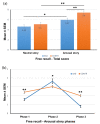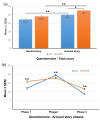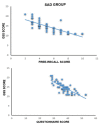Declarative Memory Impairment and Emotional Bias in Recurrent Depression with a Seasonal Pattern: The Interplay between Emotion and Cognition in Seasonal Affective Disorder
- PMID: 36291286
- PMCID: PMC9599318
- DOI: 10.3390/brainsci12101352
Declarative Memory Impairment and Emotional Bias in Recurrent Depression with a Seasonal Pattern: The Interplay between Emotion and Cognition in Seasonal Affective Disorder
Abstract
Seasonal Affective Disorder (SAD) is a subtype of Major Depressive Disorder (MDD) with a seasonal pattern. Although it is a pathological condition limited to specific seasons of the year, during the symptomatic period, patients may experience a significant impairment of well-being and daily quality of life as a result of the depressed mood, associated with other symptoms defined as atypical of MDD. While extensive evidence of memory deficits has been found in MDD, explicit memory impairments in SAD are insufficiently studied. This study aims to investigate the cognitive processing of emotional stimuli in women with SAD, in particular the interplay between emotions and declarative memory. One hundred and twenty young women, screened from an initial number of 1125 university students, were divided into two groups, an experimental one that included 60 medically untreated women affected by “winter type SAD” and a control group of 60 non-SAD women. Different subjects were randomly submitted to two types of audio−visual stories, neutral or arousal, and then their memory performances were analyzed by means of a free-recall test and a recognition memory test. In both the free-recall test (p < 0.008) and in the recognition memory test (p < 0.002), the SAD group showed impaired memory performances. Taken together, our novel key findings suggest that SAD is characterized by impairment in declarative memory and attentional bias for emotional negative stimuli.
Keywords: cognition; declarative memory; depression; emotion; seasonal affective disorder; seasonality.
Conflict of interest statement
The authors declare no conflict of interest.
Figures





Similar articles
-
Emotional Bias among Individuals at Risk for Seasonal Affective Disorder-An EEG Study during Remission in Summer.Brain Sci. 2023 Dec 20;14(1):2. doi: 10.3390/brainsci14010002. Brain Sci. 2023. PMID: 38275507 Free PMC article.
-
Season-independent cognitive deficits in seasonal affective disorder and their relation to depressive symptoms.Psychiatry Res. 2017 Nov;257:219-226. doi: 10.1016/j.psychres.2017.07.056. Epub 2017 Jul 30. Psychiatry Res. 2017. PMID: 28780278
-
Differences in clinical and cognitive variables in seasonal affective disorder compared to depressive-related disorders: Evidence from a population-based study in Finland.Eur Psychiatry. 2017 Jul;44:9-16. doi: 10.1016/j.eurpsy.2017.03.003. Epub 2017 Mar 28. Eur Psychiatry. 2017. PMID: 28535408
-
Light therapy for preventing seasonal affective disorder.Cochrane Database Syst Rev. 2019 Mar 18;3(3):CD011269. doi: 10.1002/14651858.CD011269.pub3. Cochrane Database Syst Rev. 2019. PMID: 30883670 Free PMC article.
-
Cognitive deficits in bipolar disorders: Implications for emotion.Clin Psychol Rev. 2018 Feb;59:126-136. doi: 10.1016/j.cpr.2017.11.006. Epub 2017 Nov 21. Clin Psychol Rev. 2018. PMID: 29195773 Free PMC article. Review.
Cited by
-
Relationship between sun exposure and seasonal affective disorder symptoms in rural older people with different personalities: a cross-sectional study.BMC Public Health. 2024 Sep 20;24(1):2568. doi: 10.1186/s12889-024-20074-y. BMC Public Health. 2024. PMID: 39300416 Free PMC article.
-
Emotional Bias among Individuals at Risk for Seasonal Affective Disorder-An EEG Study during Remission in Summer.Brain Sci. 2023 Dec 20;14(1):2. doi: 10.3390/brainsci14010002. Brain Sci. 2023. PMID: 38275507 Free PMC article.
References
-
- Hinterbuchinger B., König D., Gmeiner A., Listabarth S., Fellinger M., Thenius C., Baumgartner J.S., Vyssoki S., Waldhoer T., Vyssoki B., et al. Seasonality in schizophrenia-An analysis of a nationwide registry with 110,735 hospital admissions. Eur. Psychiatry. 2020;63:e55. doi: 10.1192/j.eurpsy.2020.47. - DOI - PMC - PubMed
Grants and funding
LinkOut - more resources
Full Text Sources

